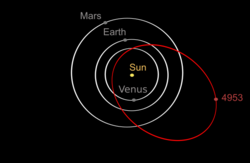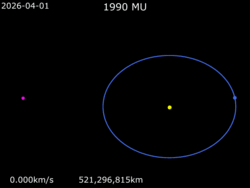Astronomy:(4953) 1990 MU
 Orbit of asteroid (4953) 1990 MU viewed from the north ecliptic pole at the epoch of 1 January 2010 | |
| Discovery[1] | |
|---|---|
| Discovered by | Robert H. McNaught |
| Discovery site | Siding Spring Obs |
| Discovery date | 23 June 1990 |
| Designations | |
| (4953) 1990 MU | |
| Minor planet category | NEO · Apollo · PHA[1] |
| Orbital characteristics[1] | |
| Epoch 13 January 2016 (JD 2457400.5) | |
| Uncertainty parameter 0 | |
| Observation arc | 41.16 yr (15032 days) |
| Earliest precovery date | 21 July 1974 (Siding Spring Observatory) |
| |{{{apsis}}}|helion}} | 2.6874 astronomical unit|AU (402.03 Gm) |
| |{{{apsis}}}|helion}} | 0.55508 AU (83.039 Gm) |
| 1.6212 AU (242.53 Gm) | |
| Eccentricity | 0.65762 |
| Orbital period | 2.06 yr (754.00 d) |
| Average Orbital speed | .4774 deg/day |
| Mean anomaly | 197.22° |
| Mean motion | 0.47746°/day |
| Inclination | 24.388° |
| Longitude of ascending node | 77.737° |
| 77.748° | |
| Earth MOID | 0.0256049 AU (3,830,440 km)[1] |
| Physical characteristics | |
| Mean diameter | 2.8 km[2] |
| Rotation period | 14.218 h |
| Absolute magnitude (H) | 14.1[1] |
(4953) 1990 MU (prov. designation: 1990 MU) is a large Earth-crossing asteroid (ECA) belonging to the Apollo group of near-Earth objects which also cross the orbits of Mars and Venus. At approximately 3 km in diameter,[3] it is one of the largest known ECAs.[4] It has been assigned a permanent number from the Minor Planet Center (4953) indicating that its orbit has been very well determined. With an observation arc of 45 years, the asteroid's trajectory and uncertainty regions are well known through to the year 2186.[1]
Description
1990 MU was first observed over three nights in 1990. By itself, this was not enough for the asteroid to be given a permanent number since the orbit could not be calculated accurately enough for the object to be subsequently recovered. However, the object was precovered by the Anglo-Australian Near-Earth Asteroid Survey on six photographic plates from the UK Schmidt Telescope dating back to 1974. This technique has more success with the Amor group of asteroids which do not cross the orbit of the Earth and consequently have long periods of opposition when they can be observed. In this respect the Apollo asteroid 1990 MU is somewhat unusual.[5]
1990 MU has an Earth minimum orbit intersection distance (MOID) of 0.0263 AU (3,930,000 km), which is close enough to classify it as a potentially hazardous asteroid (PHA). It will make a close approach to Earth on 6 June 2027 at 0.0308 AU (4,610,000 km),[1] becoming as bright as apparent magnitude 9.7 on 8 June 2027,[6] and even closer on 5 June 2058 at 0.0231 AU (3,460,000 km). It also made a close approach to Venus on 5 October 2012 at 0.0567 AU (8,480,000 km) and will again on 3 September 2041 at 0.0581 AU (8,690,000 km).[1] 1990 MU has made close approaches to Earth in the past; in June 1996 it approached within 0.25 AU and in May 1990 it approached to 0.1418 AU.[7] The Earth MOID of 1990 MU has been decreasing (becoming more hazardous) during the 20th century, while the Venus MOID (0.0455) has been increasing.[8]
Besides its original discovery at Siding Spring Observatory in Australia, 1990 MU has also been studied by radar at Goldstone Observatory in California, and Arecibo Observatory in Puerto Rico.[9][10] Lightcurves have been obtained at La Silla Observatory in Chile.[11]
The albedo of 1990 MU was measured by the ExploreNEOs project of the Spitzer Space Telescope in August 2009. The result obtained was 0.79 and was the second highest albedo measured by the project. However, ExploreNEO do not believe this is a plausible figure, they state that the albedo of an NEO is not likely to be much over 0.5 and their measurement uncertainty is "around a factor of 2".[12]
The Gaia mission of the European Space Agency, launched in December 2013,[13] has been tasked with measuring the Yarkovsky effect on near-Earth asteroids (NEAs). The Yarkovsky effect is a small non-gravitational force on rotating bodies that can affect their trajectories. Its effect on small bodies like asteroids can be significant and needs to be taken into account in predicting an asteroid's position. 1990 MU has been selected as one of the most promising NEAs for this measurement by Gaia.[14]
| Asteroid | Date | Nominal approach distance (LD) | Min. distance (LD) | Max. distance (LD) | Absolute magnitude (H) | Size (meters) |
|---|---|---|---|---|---|---|
| 3200 Phaethon[19] | 2093-12-14 | 7.714 | 7.709 | 7.719 | 14.6 | 5100 |
| (4953) 1990 MU[20] | 2058-06-05 | 8.986 | 8.984 | 8.988 | 14.1 | 3000 |
See also
References
- ↑ 1.0 1.1 1.2 1.3 1.4 1.5 1.6 1.7 "JPL Small-Body Database Browser: 4953 (1990 MU)". Jet Propulsion Laboratory. https://ssd.jpl.nasa.gov/sbdb.cgi?sstr=4953;cad=1#cad. Retrieved 13 May 2018.
- ↑ "( 4953) 1990 MU". The Near-Earth Asteroids Data Base at E.A.R.N. http://earn.dlr.de/nea/004953.htm. Retrieved 16 June 2012.
- ↑ B. G. Marsden, G. V. Williams, "Earth-crossing asteroids", Hazards due to Comets and Asteroids, pages 1233–1238, University of Arizona Press, 1994 ISBN:0816515050.
- ↑ D. I. Steel, R. H. McNaught, K.S. Russell, "The Anglo-Australian Near-Earth Asteroid Survey", Proceedings of the Liege International Colloquium 30, pages 219–221, 24–25 June 1992 Bibcode: 1992LIACo..30..219S.
- ↑ R. H. McNaught, D. I. Steel, K. S. Russell, "Near-Earth asteroids on archival Schmidt plates", The Future Utilisation of Schmidt Telescopes: Astronomical Society of the Pacific Conference Series, volume 84, pages 170–173, 1995 Bibcode: 1995ASPC...84..170M.
- ↑ "AstDys 2003AZ84 Ephemerides". Department of Mathematics, University of Pisa, Italy. https://newton.spacedys.com/astdys/index.php?pc=1.1.3.1&n=4953&oc=500&y0=2027&m0=6&d0=5&h0=21&mi0=44&y1=2027&m1=6&d1=8&h1=23&mi1=44&ti=30.0&tiu=minutes. Retrieved 13 May 2018.
- ↑ Donald K. Yeomans, Paul W. Chodas, "Predicting close approaches of asteroids and comets to Earth", Hazards due to Comets and Asteroids, pages 241–257, University of Arizona Press, 1994 ISBN:0816515050.
- ↑ Edward Bowell, Karri Muindon, "Earth-crossing asteroids and comets: groundbased search strategies", Hazards due to Comets and Asteroids, pages 149–195, University of Arizona Press, 1994 ISBN:0816515050.
- ↑ S. J. Ostro, D. Choate, P. Dendrenos, J. Giogini, D. L. Hills, D. Howard, R. F. Jurgens, M. S. Keesey, D. L. Mitchell, R. Rose, K. D. Rosema, M. A. Slade, D. R. Strobert, R. Winkler, D. K. Yoemans, "Asteroid radar astronomy at Goldstone in the 1990s", Bulletin of the American Astronomical Society, volume 26, page 1165, June 1994 Bibcode: 1994DPS....26.2708O
- ↑ Steven J. Ostro, Jon D. Giorgini, "The role of radar in predicting and preventing asteroid and comet collisions with Earth", Mitigation of Hazardous Comets and Asteroids, pages 38–65, Cambridge University Press, 2004 ISBN:0521827647. Accessible preprint at JPL.
- ↑ Johan S. V. Lagerros, Claes-Ingvar Lagerkvist, Mats Lindgren, Gerhard Hahn, "Differential CCD photometry of 1980 Tezcatlipoca, 2368 Beltrovata, 4769 Castalia, 4953 1990 MU and 4954 Eric", IAU Symposium 160: Asteroids, Comets, Meteors 1993 (abstracts), page 176, Lunar Planetary Institute, 1993 Bibcode: 1993LPICo.810..176L
- ↑ D. E. Trilling, M. Mueller, J. L. Hora, A. W. Harris, B. Bhattacharya, W. F. Bottke, S. Chesley, M. Delbo, J. P. Emery, G. Fazio, A. Mainzer, B. Penprase, H. A. Smith, T. B. Spahr, J. A. Stansberry, and C. A. Thomas, "ExploreNEOs. I. Description and first results from the warm Spitzer near-Earth object survey", The Astronomical Journal, volume 140, pages 770–784, September 2010 doi:10.1088/0004-6256/140/3/770.
- ↑ Chris Bergin and William Graham, "Soyuz ST-B successfully launches Gaia space observatory", NASA spaceflight.com, 18 December 2013, retrieved and archived 23 August 2014.
- ↑ Mouret, S.; Mignard, F. (2011), "Detecting the Yarkovsky effect with the Gaia mission: List of the most promising candidates", Monthly Notices of the Royal Astronomical Society 413 (2): 741–748, doi:10.1111/j.1365-2966.2010.18168.x, Bibcode: 2011MNRAS.413..741M
- ↑ "JPL Small-Body Database Search Engine". https://ssd.jpl.nasa.gov/sbdb_query.cgi?obj_group=all;obj_kind=all;obj_numbered=all;OBJ_field=0;ORB_field=0;combine_mode=AND;c1_group=OBJ;c1_item=Ai;c1_op=%3C%3D;c1_value=15;c2_group=ORB;c2_item=Bt;c2_op=%3C;c2_value=0.0386;table_format=HTML;max_rows=100;format_option=comp;c_fields=AcBhBgBjBiBnBsCjCpAiBt;.cgifields=format_option;.cgifields=obj_kind;.cgifields=obj_group;.cgifields=obj_numbered;.cgifields=combine_mode;.cgifields=ast_orbit_class;.cgifields=table_format;.cgifields=com_orbit_class&query=1&c_sort=BtA. Retrieved 13 May 2018.
- ↑ JPL Small-Body Database Browser: 16960 (1998 QS52)
- ↑ JPL Small-Body Database Browser: 89830 (2002 CE)
- ↑ JPL Small-Body Database Browser: 4183 Cuno (1959 LM)
- ↑ "JPL Small-Body Database Browser: 3200 Phaethon (1983 TB)". https://ssd.jpl.nasa.gov/sbdb.cgi?sstr=3200;old=0;orb=0;cov=0;log=0;cad=1#cad. Retrieved 13 May 2018.
- ↑ "JPL Small-Body Database Browser: 4953 (1990 MU)". https://ssd.jpl.nasa.gov/sbdb.cgi?sstr=4953;old=0;orb=0;cov=0;log=0;cad=1#cad. Retrieved 13 May 2018.
External links
- (4953) 1990 MU at NeoDyS-2, Near Earth Objects—Dynamic Site
- Ephemeris · Obs prediction · Orbital info · MOID · Proper elements · Obs info · Close · Physical info · NEOCC
- (4953) 1990 MU at ESA–space situational awareness
- (4953) 1990 MU at the JPL Small-Body Database
 |



